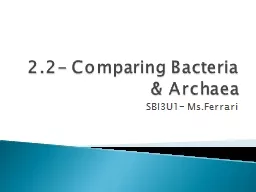

SBI3U1 MsFerrari Recall Prokaryotes are represented by 2 domains Bacteria Archaea Therefore we can compare and contrast Bacteria and Archaea by looking at the following Type of cell eukaryote Prokaryote ID: 909196
Download Presentation The PPT/PDF document "2.2- Comparing Bacteria & Archaea" is the property of its rightful owner. Permission is granted to download and print the materials on this web site for personal, non-commercial use only, and to display it on your personal computer provided you do not modify the materials and that you retain all copyright notices contained in the materials. By downloading content from our website, you accept the terms of this agreement.
Slide1
2.2- Comparing Bacteria & Archaea
SBI3U1-
Ms.Ferrari
Slide2Recall: Prokaryotes are represented by 2 domains- Bacteria, Archaea
Therefore we can compare and contrast Bacteria and Archaea by looking at the following:
Type of cell ( eukaryote? Prokaryote? )Morphology ( shape)Aggregation ( how are cells grouped together?)NutritionHabitatReproduction
How can we Compare & Contrast Domains?
Slide3Cell Type:
Both are prokaryotic
Morphology:
similar shape-
cocci (spheres), bacilli (rods), and spirilli ( spiral cells)Nutrition: both either consume other organisms or use inorganic compoundsHabitat: Both are found in extreme environments; more archaea live in extreme habitats (extremophiles), while more bacteria live in moderate habitats (mesophiles)Reproduction: binary fission
Similarities btw. Archaea & Bacteria
Slide4Differences btw. Archaea & Bacteria
BACTERIA
ARCHAEA
1) shaped
like pyramids, cubes, or rods with star cross-sections, 2) Some are photosynthetic, 3) live anaerobically in human guts; 1) shaped like plates or rectangular rods2) Some aare methanogenetic
(produce methane gas as by-product).
3)live
anaerobically in cattle guts.
Slide5Most common forms in both bacteria and archaea are spheres and rods.
Spherical forms are called
cocciRod forms are called bacilliSpiral forms are called spirilli cocci bacilli
spirilli
Comparing Morphology
Slide6Three Types of
Extremophiles
Thermophiles
live in hot springs and deep sea vents, enduring temperatures over 100ºC. Example: Archaea MethanopyrusAcidophiles live in volcanic craters and mine drainage lakes, enduring pH levels lower than 3. Example: Archaea PicrophilusHalophiles
live in salt lakes and
inland seas, enduring salt concentrations
above 20%.
Example: Archaea
Halococcus
Chapter 2: Diversity: From Simple to Complex
Section 2.2
Comparing Habitat
Slide7Comparing Reproduction:
Binary
Fission
Binary fission is
asexual reproduction.Both domains lack a nucleus therefore the only way to reproduce is asexually.
Slide8In
less
favorable
conditions, DNA can be exchanged instead of reproducing by binary fission. Conjugation= one cell links to another by a pilus (tube) and transfers a copy of some or all of the chromosomes. Comparing Reproduction: Conjugation
UNIT 1
Chapter 2: Diversity: From Simple to Complex
Section 2.2
Slide9Classifying Bacteria: Gram Staining
Bacteria
that will stain because they contain a thick protein layer on their cell wall are
Gram-positive (become
purple)Bacteria that will not stain because they have a thin protein layer are Gram-negative (become pink).
Slide10Bacteria & Human Health
A)Clostridium
botulinum
causes
food poisoningB)Streptococcus pyogenes causes strep throatC)Streptococcus
mutans causes
tooth decay
Slide11Read and make notes 2.1 Pgs.59-68Complete pg.
66 Q# 1, 2, 4, 5, 8, 11
Homework